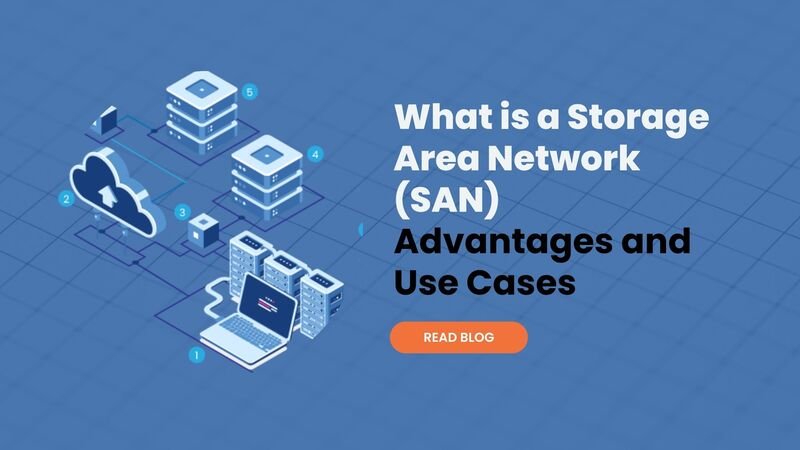SAN storage is an excellent option for enterprises with high storage needs and demanding applications. However, sizing the appropriate storage appliance is critical to performance and data protection. It requires considering workloads, data types, and data growth rates to determine CPU and system memory specifications accurately.
Businesses must also consider upfront and ongoing maintenance costs. Selecting the right SAN monitoring tools that offer accurate capacity forecasting and reporting capabilities is essential to avoid the risks of costly SAN downtime.
What is a SAN?
Nfina Storage Area Network (SAN) is a network architecture that centralizes storage resources and facilitates access to data from multiple servers through a high-speed connection. It allows you to access and use your storage more efficiently, improving performance and reducing costs.
A SAN’s fabric layer is the network that connects servers to storage devices. This network uses a combination of fiber optic cables (for high-speed networking over long distances) and traditional copper-based cabling to connect host HBA ports to corresponding ports on SAN storage devices. The fabric also includes SAN networking devices like switches, gateways, and routers that manage network traffic and provide redundancy.
This redundancy ensures that even if a device or cable fails, your data remains accessible. SANs can also include built-in data protection mechanisms to protect your most important information from loss or corruption. In addition, SANs often support centralized storage management, simplifying tasks such as backups and data migration. It can make it easier to start with a SAN and help you scale your storage capacity quickly.
What are the benefits of a SAN?
Storage Area Networks offer many benefits to businesses, including centralized storage management, improved reliability, and quick recovery from hardware failure. SANs free devices from being dependent on specific servers and allow shared access to storage devices, making it easier to assign storage based on application needs.
SANs use high-speed connections, like Fibre Channel or iSCSI, to transfer data between servers and storage devices. Switches manage this data flow and ensure efficient communication between hosts and storage.
SANs are also scalable, allowing organizations to expand capacity as their storage requirements grow. Furthermore, SANs usually employ advanced technologies to improve storage performance, security, and resilience. These include RAID, disk groupings to increase device capacity and resilience, snapshots or cloning, data deduplication, self-healing, and more. These features can make a SAN the ideal choice for an organization seeking to improve its regulatory compliance, disaster recovery, and business continuity postures. However, implementing a SAN has its challenges. For example, SANs can be complex to set up and may require IT staff to spend time learning how to use them effectively.
What are the drawbacks of a SAN?
The most obvious drawback to a SAN is that it’s more complicated to set up than a traditional network. It requires more equipment, is more expensive, and must be carefully managed over time to ensure maximum performance.
Securing a Storage Area Network (SAN) is complex and requires encryption and access control to prevent unauthorized access to sensitive data.
SANs also require more maintenance than other networks, as they’re constantly under attack by viruses and malware. In addition, implementing a disaster recovery plan for a SAN is crucial to minimize downtime and ensure business continuity.
While a SAN has many benefits, it’s essential to understand the initial challenges before deciding whether it suits your organization. For guidance in navigating these hurdles, consider partnering with experts to develop and implement an effective SAN solution that aligns with your unique needs. The benefits of a SAN far outweigh the initial complexities. With faster backups, scalability, and improved reliability, you’ll quickly see why it’s worth the investment.
How do I get started with a SAN?
A SAN comprises a network fabric of interconnected storage devices and servers. By connecting clients to a SAN server and storage over a Fibre Channel (FC) network, the storage appears as a regular disk drive to the client application, increasing performance and eliminating network bottlenecks. A SAN solution also increases LAN performance by separating storage traffic from data transfer on the local area network (LAN).
A high-speed SAN infrastructure is ideal for organizations that use large amounts of storage for database systems, applications, or virtualization environments. By removing a single point of failure and providing scalability, SANs make it possible to keep up with the dynamic requirements of these environments.
A SAN requires several components, including FC host bus adapters and switches, fiber cables, disk arrays, and traditional or solid-state storage drives. Choosing a SAN architecture that aligns with performance specifications is critical for optimal operation. A centralized management layer provides a way to control the functionality of each component and implement security features across the entire SAN architecture.
How do I manage a SAN?
SANs centralize and remove storage from individual servers, allowing administrators to manage storage resources from a centralized location. This is important for many reasons, including improved performance and scalability, better availability, and meeting compliance and security requirements.
A SAN can be managed physically, through a dedicated network connection between switches and HBAs, or logically through virtualization software to find and map storage devices. Either way, a SAN must be configured to meet the organization’s needs.
It means identifying goals, workloads, and storage requirements and then planning the SAN infrastructure accordingly. It also means incorporating DR mechanisms, such as synchronous or asynchronous replication and off-site backups.
Finally, it is essential to monitor SAN health. It can be done with a service that watches the physical and logical network configuration to identify potential issues. By using alerts and reporting, it can be easy to ensure a SAN functions correctly and meets the company’s business objectives. It can also help to prevent costly outages and improve data availability.



